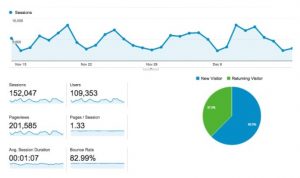Your website’s data matters. By tracking your site’s most important metrics, you can get a valuable look at how well your SEO strategy is working; what a typical customer does on your site; and even what your competitors are doing differently. To understand your web analytics, you need the right tools – and there are plenty of powerful tools out there. Here’s a round-up of ten analytics tools that you may wish to consider using.
1. Google Analytics

A display in Google Analytics
When it comes to web analytics tools, Google Analytics[1] is the gold standard. It’s simple to set up, customizable, and provides all the basic information you could want about your site. With Google Analytics, you can collect data on your audience (such as age, location, and devices), and observe how visitors find, interact with, and leave your site. As it’s so popular, Google Analytics tends to be easy to integrate with other platforms. If you aren’t sure which web analytics tool is right for you, you can’t go wrong with this one.
Price: Google Analytics is free for most users. Businesses that need a large amount of data can also look into Google Analytics 360, the paid enterprise version of the tool. Cost varies based on each company’s individual needs, but expect the price to be steep – third-party sources estimate that GA 360 starts at $150,000 per year.
2. Crazy Egg

Crazy Egg’s heatmaps and scroll maps make this tool popular among data lovers.

